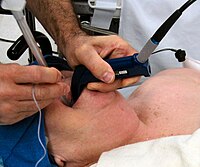
Photo from wikipedia
OBJECTIVE To compare the effects of Liuzijue Qigong and conventional respiratory training on trunk control ability and respiratory muscle functions in patients at an early recovery stage from stroke. DESIGN… Click to show full abstract
OBJECTIVE To compare the effects of Liuzijue Qigong and conventional respiratory training on trunk control ability and respiratory muscle functions in patients at an early recovery stage from stroke. DESIGN A single-blind, randomized controlled trial. SETTING A hospital PARTICIPANTS: 60 patients within 2 months post-stroke. INTERVENTIONS The experimental group (N=30) received conventional rehabilitation training combined with Liuzijue exercise, the control group (N=30) received conventional rehabilitation training combined with conventional respiration training. The training in the 2 groups was conducted 5 times per week for 3 weeks. MAIN MEASURES Trunk Impairment Scale (TIS), Maximum Inspiratory Pressure (MIP), Maximum Expiratory Pressure (MEP), Forced Expiratory Volume in the first second (FEV1), Forced Vital Capacity (FVC), Peak Expiratory Flow (PEF), Maximum Expiratory Mid-flow (MMEF), diaphragmatic movement, the change of intra-abdominal pressure (IAP), Berg Balance Scale (BBS) and Modified Barthel Index (MBI). All outcome measures were assessed twice (at baseline and 3 weeks). RESULTS Both groups significantly improved in TIS, MIP, FVC, PEF, the change of IAP, BBS and MBI when pre- and post-assessments (P<0.05) were compared. In contrast to the control group, there was a significant difference in the experimental group in the static sitting balance subscale (P=0.014), dynamic balance subscale (P=0.001), coordination subscale (P<0.001), TIS total scores (P<0.001, ES=0.9), MIP (P=0.012, 95% CI 2.23 to 17.69, ES=0.67), MEP (P=0.015, 95% CI 1.85 to 16.57, ES=0.65), the change of IAP (P=0.001), and MBI (P=0.016, 95% CI 1.51 to 14.16, ES=0.64). No significant differences were found between the 2 groups in FEV1 (P=0.24), FVC (P =0.43), PEF (P=0.202), MMEF (P=0.277), the diaphragmatic movement of quiet breathing (P=0.146) and deep breathing (P=0.102), and BBS (P=0.124). CONCLUSION The Liuzijue showed more changes than conventional respiratory training in improving trunk control ability, respiratory muscle functions and ADL ability in patients at an early recovery stage from stroke.
Journal Title: Archives of physical medicine and rehabilitation
Year Published: 2020
Link to full text (if available)
Share on Social Media: Sign Up to like & get
recommendations!